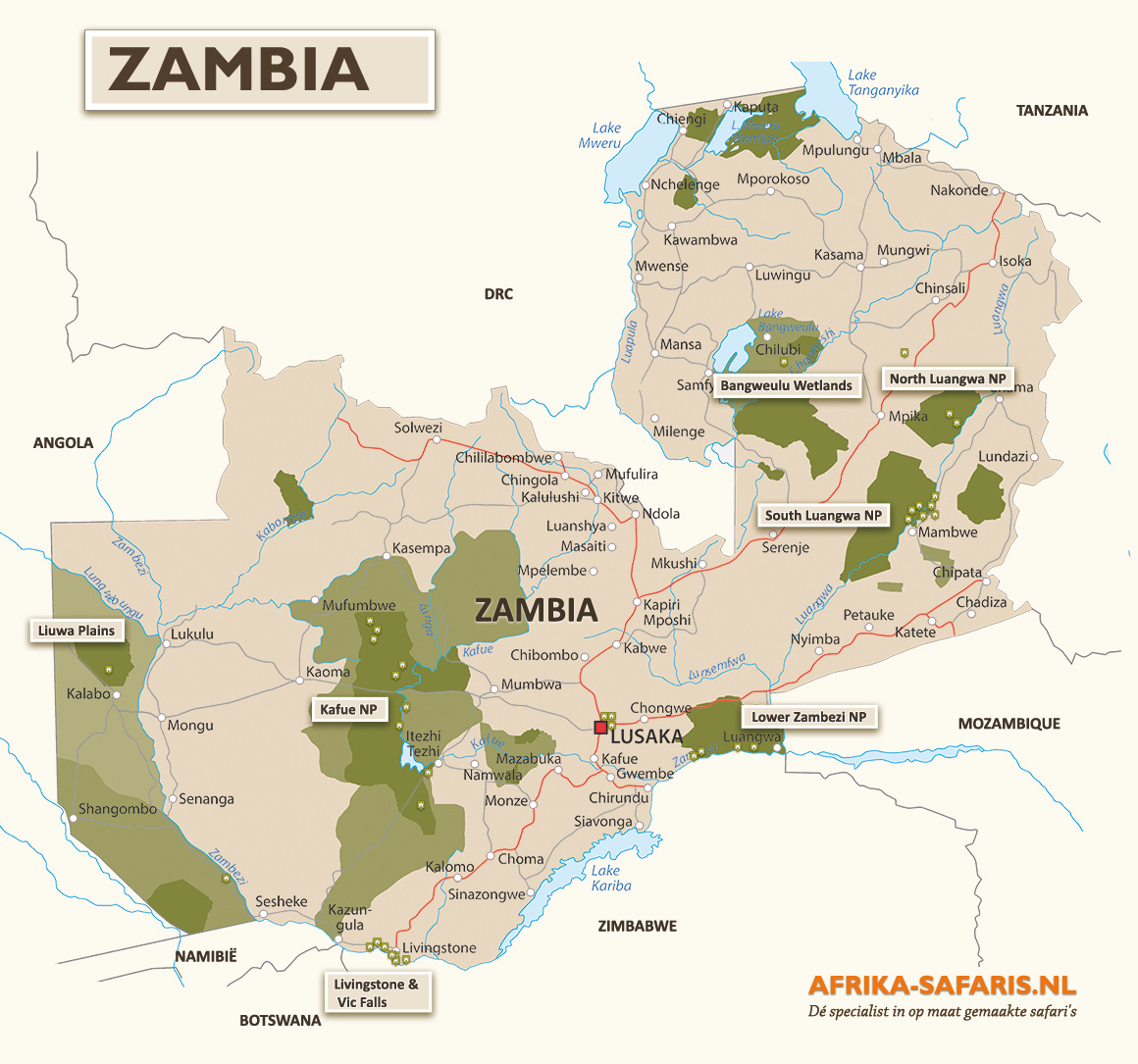On safari in Zambia
The home of walking safaris in Africa. Zambia, and South Luangwa in particular, is known for nature walks; so-called game-walks. Of course, around the Victoria Falls, there are also all sorts of options, mostly focused on experiencing the power and might of the Zambezi River.
Animal life is also plentiful in the area around the falls, especially during the dry season. It can be seen during boat trips on the river or during game drives in Mosi-oa-Tunya National Park, west of the falls. Buffalo, giraffe, zebra, wildebeest, impala and even white rhinos can be seen in the small park. The birdlife is also rich and varied.
Livingstone is also worth visiting, especially for adventurers. Not for nothing is it called the “adrenaline capital” of southern Africa.
Nature reserves in Zambia
South Luangwa National Park
The 9050 km2 South Luangwa National Park is located in the lower part of the Luangwa Valley. Characteristic of the park is its lifeline, the Luangwa River. An imposing watercourse that meanders through the landscape. On its banks, with its typical sandbanks, you will find very high concentrations of game. Over the years, the river has carved out a multitude of flood plains and channels. In the dry winters, these remain as lagoons and horseshoe-shaped lakes supplied with water. These are a magnet for the area’s wildlife. Further from the river, the landscape consists of mopane forests, savanna, and hilly countryside. South Luangwa is home to over 60 species of large mammals: large herds of elephant and buffalo, as well as puku, impala, waterbuck, warthog, and kudu. Unique subspecies such as Cookson’s wildebeest and Thornicroft’s giraffe are also found in the Luangwa Valley. Lions are frequent and Luangwa is also known for its very high density of leopards. In addition, over 400 bird species have been observed, including Lilian’s Lovebird and Racket-tailed Roller.
Several lodges and bush camps can be booked in South Luangwa. These include Luangwa River Camp, Mfuwe Lodge, Nkwali Camp, Puku Ridge Camp and Mchenja Bushcamp.
Livingstone en Victoria Falls
The Victoria Falls are considered one of the seven natural wonders of the world. They are known locally as Mosi-oa-Tunya – “the Smoke that Thunders.” A name that accurately describes the sight of the falls. From a distance, the plume of mist can already be seen. It is formed by the water of the Zambezi River. It plunges down with thunderous force. The area is extraordinarily beautiful, both at the falls themselves, and at the photogenic course of the river upstream.
The main town on the banks of the Zambezi is Livingstone, which, with all the opportunities for spectacular activities – abseiling, bungee-jumping, white-water rafting and canoeing – is known as the “adrenaline capital” of southern Africa.
On the Zambian side of the Zambezi, accommodations such as The River Club and Toka Leya guarantee a pleasant stay. We can also provide various accommodations on the Zimbabwean side.
Kafue National Park
With a massive area of 22,500 km2, Kafue National Park is one of the largest parks in Africa. The pristine area is wild, remote, and very diverse. The northwest is dominated by the Busanga Swamps, a vast swamp area where papyrus vegetation is mainly found. The swamp flows into another distinctive area: the vast flood plain of the Busanga Plains. This plain consisting of grasslands and isolated tree islands is temporarily flooded each year by rainfall and water supply from the surrounding rivers. These rivers, the Lunga, Lufupa and Kafue, traverse the area and are lined with lush riverine forests. Furthermore, the landscape consists of Miombo forests, open plains and dense islands. Conditions in the area are very good for all kinds of African wildlife. In addition to large concentrations of buffalo, wildebeest, puku and lechwe, the Busanga Plains are home to relatively rare species less easily seen in southern Africa, such as Roan’s antelope, oribi and Lichtenstein’s hartebeest. In addition, there are large numbers of lions. Where lions are less at home, cheetahs and wild dogs can be seen. Birdlife is also abundant, and includes many unusual specimens such as the beautifully colored Ross’s Turaco and the swamp species Locust Finch.















